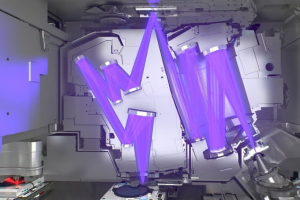Chinese semiconductor equipment makers are seeing a ‘faster than expected’ progress in production technology, fuelled by a surge in revenue, as the country’s chipmakers rush to slash their use of foreign machinery.
The shift, sparked by tightening US restrictions on exports of advanced chips and chipmaking tools to China, marks a turning point for the industry.
“Before the sanctions, top Chinese foundries would use a small amount of machines from Chinese suppliers, but they would really only experiment with new equipment when they would add new capacity,” one source briefed by the companies said.
Also on AF: US Expands Ban on Top AI Chips, Curbs to Hit Many Countries
“Now, foundries are testing out Chinese-made equipment for every foreign machine they own and if they find that it meets their needs, they replace all of them,” he said.
“They want as few foreign machines as feasible.”
Increasing orders from Chinese foundries for equipment-makers at home suggests chipmakers in the country have accepted US restrictions on technology imports are unlikely to ease and could get worse.
It also shows that the industry believes that self-reliance — as urged by Chinese President Xi Jinping — is the way forward.
Quicker tech progress ‘than expected’
Analysts said that Chinese manufacturers were getting better at producing equipment in areas such as etching and cleansing, where they compete globally with the likes of US firms Applied Materials and Lam Research.
Some machines of etching equipment maker AMEC have entered production lines for chips as advanced as those using 5 nanometre technology, according to the company’s earnings reports.
AMEC’s etching equipment is used to remove excess material from the surface of silicon wafers.
One China-based semiconductor analyst said the quality of Chinese-made chip equipment was improving faster than he had anticipated, estimating that they were two years ahead of his original estimates.
“There is definitely huge progress happening in the Chinese semiconductor equipment space, as reflected in the strong revenue growth metrics,” he said.
View this post on Instagram
Soaring sales
Research shows that Chinese equipment manufacturers, such as AMEC and toolmaker Naura, have won a much higher proportion of tenders from domestic foundries in recent months, compared to previous years.
Nearly half, or 47%, of all machinery equipment tenders by Chinese foundries from January to August 2023 were won by local manufacturers, according to an analysis of 182 tenders by Huatai Securities last month.
From July to August 2023, 62% were won by Chinese suppliers compared to only 36% from March to April, the brokerage’s analysts said.
AMEC and Naura in particular are receiving more orders from China’s largest foundries SMIC and Hua Hong Semiconductor, a source said.
The equipment-related revenue of China’s top 10 domestic equipment manufacturers also grew 39% year-on-year for the first half of 2023, representing $2.2 billion in sales, according to a report by CINNO Research.
Long way to go
Despite the quick progress, some pain points, particularly lithography, continue to weigh on China’s chip industry. Lithography requires extremely complex optics and process precision.
China has not been able to procure extreme ultraviolet (EUV) lithography machines needed to make the most advanced chips.
Making matters worse, the US has now barred even some less advanced deep ultraviolet (DUV) lithography systems from entering China.

The Huatai Securities report revealed that for the first eight months of 2023, only one tender for lithography equipment was awarded to a Chinese company, out of many bids.
China’s imports of lithography machines and components used in such machines from the Netherlands rose 81% year-over-year to $3.3 billion from January to August, according to Reuters’ calculations based on data from China’s customs.
The Netherlands’ ASML, Europe’s largest technology company and a maker of the advanced technology, reported on Wednesday that sales to China represented nearly half of its revenue for the third quarter of 2023.
But the lithography challenge has not stopped Chinese firms from achieving some breakthroughs.
Analysts believe that Huawei and SMIC were able to make an advanced chip for the Mate 60 Pro phone by tweaking DUV machines they were still able to purchase from ASML.
“Local players still lack capability to supply a full set of equipment, such as EUV,” said Nori Chiou, investment director at White Oak Capital, adding that Chinese manufacturers are focused on covering mature node equipment.
“It’s a long way to go to see advanced semiconductor equipment made in China.”
- Reuters, with additional editing by Vishakha Saxena
Also read:
Threat of More Chip Curbs Spurs Warnings on China Innovation
China Exploiting Open Source RISC-V Chip Tech, Warn Senators
ASML to Ship Top Tech to China Even as Dutch Chip Ban Starts
New Huawei Phone Spurs Fear China Got Around US Chip Curbs
Chinese Envoy Warns US: More Chip Bans and We’ll Hit Back
Blacklisted China Chip Giant SMIC Earned $1.5bn in US – WSJ
























